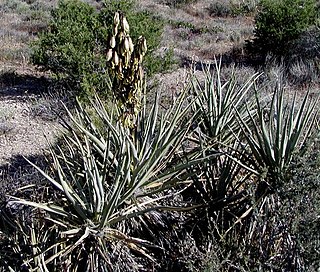
Yucca baccata is a common species of yucca native to the deserts of the southwestern United States and northwestern Mexico, from southeastern California north to Utah, east to western Texas and south to Sonora and Chihuahua. It is also reported in the wild in Colombia.

Yucca schidigera, also known as the Mojave yucca or Spanish dagger, is a flowering plant native to the southwest deserts of North America.

Gaillardia pulchella is a North American species of short-lived perennial or annual flowering plants in the sunflower family.

Dasylirion wheeleri is a species of flowering plant in the asparagus family (Asparagaceae), native to arid environments of northern Mexico and the southwestern United States.

Nolina parryi is a flowering plant that is native to Baja California, southern California and Arizona.

Erigeron divergens is a species of flowering plant in the family Asteraceae known by the common name spreading fleabane. It is native to western North America.

Geraea canescens, commonly known as desert sunflower, hairy desert sunflower, or desert gold, is an annual plant in the family Asteraceae. The genus name comes from the Greek geraios, referring to the white hairs on the fruits.

Justicia californica is a deciduous species of flowering shrub native to the deserts of southern California, southern Arizona, and northern Mexico. Its common names include chuparosa, hummingbird bush, and beloperone.
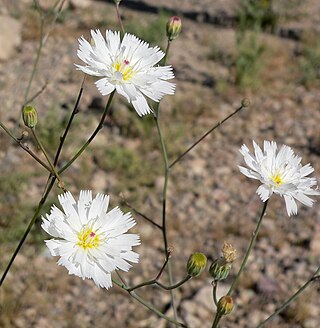
Atrichoseris is a genus of plants in the family Asteraceae. It contains only one known species, Atrichoseris platyphylla, known by the common names tobacco weed, parachute plant, and gravel ghost.
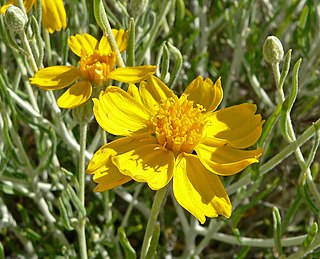
Psilostrophe cooperi is a flowering plant in the daisy family known by the common names Cooper's paper daisy and whitestem paperflower. It is native to the Mojave and Sonoran Deserts of California, the Southwestern United States, and northwestern Mexico.

Baileya multiradiata is a North American species of sun-loving wildflowers native to the deserts of northern Mexico and the Southwestern United States. It has been found in the States of Sonora, Chihuahua, Coahuila, Durango, Aguascalientes, California, Arizona, Nevada, Utah, New Mexico, and Texas.

Antirrhinum filipes is an annual species of North American snapdragon, usually known by the common name yellow twining snapdragon. This herbaceous plant is native to deserts of the southwestern United States and northern Mexico, where it is common.
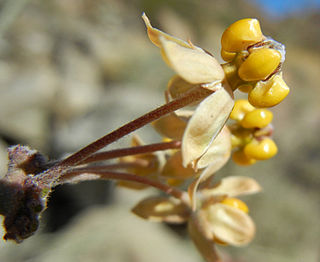
Asclepias albicans is a species of milkweed known by the common names whitestem milkweed and wax milkweed. It is native to the Mojave and Sonoran Deserts of California, Arizona, and Baja California. This is a spindly erect shrub usually growing 1 to 3 meters tall, but known to approach 4 meters. The sticklike branches are mostly naked, the younger ones coated in a waxy residue and a thin layer of woolly hairs. The leaves are ephemeral, growing in whorls of three on the lower branches and falling off after a short time. They are linear in shape and up to 3 centimeters long. The inflorescence is an umbel about 5 cm (2 in) wide which appears at the tips of the long branches and sprouting from the sides at nodes. The inflorescence contains many purple-tinted greenish flowers, each about 1.5 cm wide, with a central array of bulbous hoods, and corollas reflexed back against the stalk. In it's native range it is an evergreen perennial. The plant usually blooms all year long. The fruit is a large, long, thick follicle which dangles from the branch nodes.
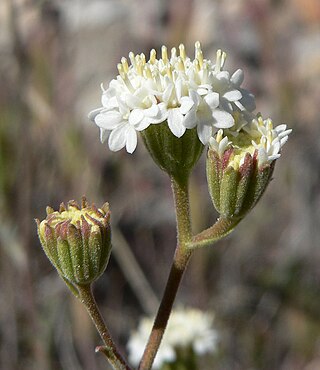
Chaenactis stevioides, with the common names Esteve's pincushion and desert pincushion, is a species of flowering plant in the daisy family. It is also sometimes called false yarrow or broad-leaved Chaenactis.

Enceliopsis nudicaulis is a North American species of flowering plants in the family Asteraceae known by the common name nakedstem sunray, or naked-stemmed daisy.

Machaeranthera tanacetifolia is a species of flowering plant in the family Asteraceae known by the common names tansyleaf tansyaster and Tahoka daisy.

Sesuvium verrucosum is a species of flowering plant in the family Aizoaceae known by the common names western sea-purslane and verrucose sea-purslane.

Antennaria parvifolia is a species of flowering plant in the family Asteraceae, known by the common names Nuttall's pussytoes and small-leaf pussytoes. It is native to western and central North America.

Tetraneuris acaulis is a North American species of flowering plants in the sunflower family. Common names include angelita daisy, stemless four-nerve daisy, stemless hymenoxys, butte marigold, and stemless rubberweed.

Funastrum cynanchoides, also known as fringed twinevine, twining milkweed or climbing milkweed, is a perennial plant in the family Apocynaceae that grows twining through other plants in the Mojave Desert and Sonoran Desert. It has milky sap and smells pungent. It is similar to Funastrum hirtellum.




















